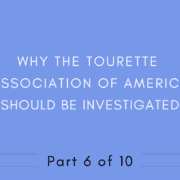What’s the Role of the Neurotransmitter GABA in Tourette Syndrome?
Press release October 1, 2015: A chemical in the brain could potentially be harnessed to help young people with Tourette Syndrome (TS) to overcome the physical and vocal tics associated with the neurological disorder, say researchers.
 In a paper published in the journal Trends in Cognitive Sciences, academics from The University of Nottingham reviewed recent evidence that the neurochemical known as Gamma Aminobutyric acid (GABA) is responsible for dampening down the hyperactivity that causes the repetitive and involuntary movements and noises.
In a paper published in the journal Trends in Cognitive Sciences, academics from The University of Nottingham reviewed recent evidence that the neurochemical known as Gamma Aminobutyric acid (GABA) is responsible for dampening down the hyperactivity that causes the repetitive and involuntary movements and noises.
They found that increases in the production of GABA as a result of changes in the brain during adolescence may contribute to an improvement in symptoms for the majority of people with TS and could offer a new avenue for treatments that lead to targeted increases of the chemical in the areas of the brain that control motor function.
Professor Stephen Jackson, in the University’s School of Psychology, said: “This is potentially a very important finding. A widely held view has been that unwanted movements such as tics in Tourette syndrome are actively suppressed through the recruitment of frontal brain areas involved in volitional action and cognitive control. The finding that individuals with Tourette syndrome exhibit increased GABA in brain areas linked to the planning and selection of movements offers a more parsimonious account for how tics might be controlled in Tourette syndrome. Namely that motor excitability is reduced locally within brain motor areas through the operation of GABA-mediated ‘tonic inhibition.’ This finding needs to be further replicated but if it proves to be a robust finding it may have important implications for therapies for neurodevelopmental disorders.”
Uncontrollable tics
Tourette’s is a neurological disorder affecting around one per cent [Editor: This is an underestimate] for all school-age children, who are affected by an evolving series of chronic physical and vocal tics which develop over time and become increasingly worse.
While children with TS can often suppress their tics, it takes great effort and can be both uncomfortable and stressful and eventually builds up until the urge to tic becomes uncontrollable.
Tics are at their worst for people with TS aged between 11 and 14 years old, but for the majority begin to improve throughout adolescence and into early adulthood. For a substantial minority though (around 20 to 30 per cent) the tics continue and for some become increasingly severe and resistant to treatment.
Previously some researchers have thought that the successful control of tics comes about over time through the purposeful and continual effort to suppress them.
However, the Nottingham team — which also includes researchers from the Institute of Mental Health — believe it is more likely that tics improve as a result of the changes in brain structure and function that occur during adolescence.
Specifically, they believe that this could largely be attributed to the neurochemical GABA — the primary inhibitory transmitter found in the central nervous system, which plays the principle role in controlling the ‘excitability’ of neurons.
The brain’s neural circuits are established early during development, with milestones including the creation and migration of neurons, the formation of synapses — the pathways by which the neurons carry their electrical signals — and the strengthening of those synaptic connections.
Self-regulating techniques
These early developments produce brain networks with a balance of influences that will excite and inhibit the brain and a disruption to this natural order has been associated with a number of common neurodevelopmental disorders including TS.
GABA is the main inhibitory neurotransmitter in the brain and contributes to almost all functions.
Findings from previous research support the idea that TS is linked to changes in the levels and function of GABA in the brain. MRI studies have consistently shown a reduced level of GABA in the brains of those with TS and post-mortem studies have shown this decrease to be as much as 50 per cent.
GABA is believed to have an inhibitory function in the areas of the brain associated with higher motor function and that a decrease in this inhibiting factor leads to the tics experienced by people with TS.
A long-standing theory is that people with TS gain control over their tics by developing self-regulating techniques to compensate, which in turn lead to a physical ‘re-wiring’ within the neural pathways of the brain.
The Nottingham experts however believe that this new control may come as a result of a higher amount of GABA, which is being released in the brain during adolescents, and which inhibits the motor regions such as the Supplementary Motor Area.
The findings could offer a new avenue for treatments which mimic this inhibiting affect within the motor function areas of the brain and could potentially offer new hope for people with TS whose disorder stays with them into adulthood and has a devastating impact on their quality of life and their ability to make friends and maintain relationships.
The paper “Inhibition, Disinhibition and the Control of Action in Tourette Syndrome,” is published in the latest issue of Trends in Cognitive Science.
Report credits: More information is available from Professor Stephen Jackson in the School of Psychology, University of Nottingham. Media Relations Manager: Emma Thorne emma.thorne@nottingham.ac.uk. The University of Nottingham, C Floor, Pope Building (Room C4); University Park, Nottingham, NG7 2RD










Has anyone tried and had success using GABA? Does anyone have a recommendation of how much to use?
Ditto lulu648 question